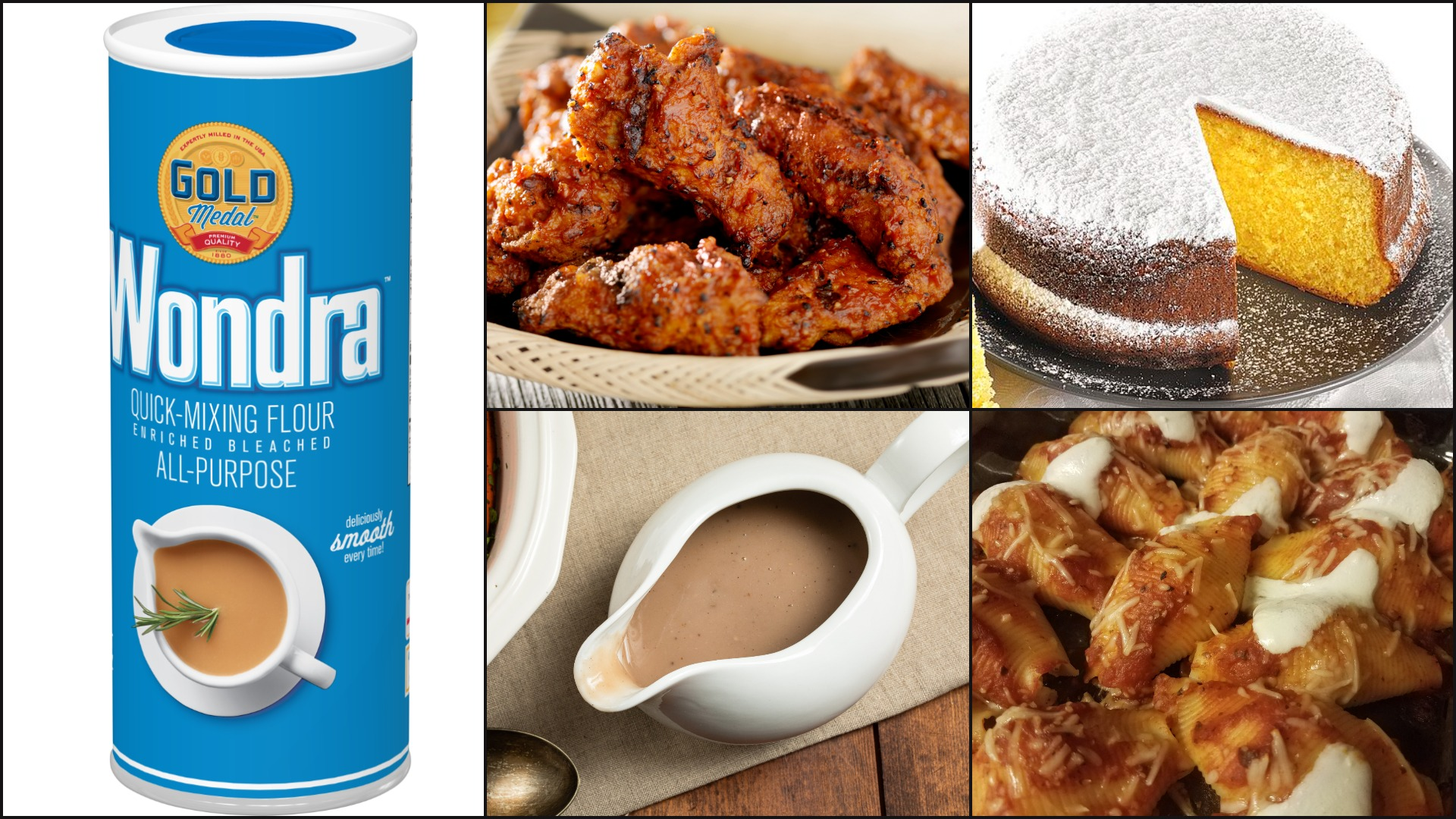The Wonders Of Wondra, The Instant Mixing Flour
Walking through the baking supply aisle, you've probably seen it: Wondra. It's a cylindrical blue can that has a photo of a gravy boat on it, and it's labeled as "Quick Mixing Flour." It's generic looking on the outside, but inside it's a versatile cooking tool that's good to have on hand for multiple purposes. But what the heck is it?
Wondra is an instant, ready-to-use flour that, like Kleenex, is recognized more by its brand name than it is by its ingredient classification. Recipes that contain instant flour will usually say Wondra instead of "instant flour." Though it comes in both a box and a tube, I prefer the cardboard tube version. It fits easily in the pantry and it's easier to sprinkle out of the top than pouring from a box.
Just what is instant flour?
Instant flour is a low-protein flour that's been pre-cooked in a process called pregelatinization, a word I wish I had a reason to use more often. Basically, it's flour that's been steamed, dried, then ground into an ultrafine powder, allowing it to dissolve smoothly and nearly instantly in any liquid it's mixed into. You can also stir it into liquids at any temperature to have it work its thickening magic.
It’s a gravy savior
Because this flour is cooked, if you're making something like gravy, you won't have to turn it into a roux before incorporating it. Instead, you can just shake the flour right into your liquid base and expect a lump-free result. I am terrible at making gravy, which is why Wondra is so...wondraful (sorry). When I'm left with any trace of raw flour, it pisses me off to no end. With Wondra, you're not going to get that gross mealy flavor you get from undercooked flour. Yes, yes, I know some of you may have some genius gravy advice for poor Dennis, but being able to shake and mix flour into a sauce without messing it up is awesome. Gravy is a gift to mankind, and I like to think of it as sippin' sauce. Anything that makes it easier to prepare is a godsend.
We recently talked about Jacques Pépin's preferred ingredient for thickening soups, and Wondra is sort of like my version of his instant mashed potato flakes, mainly for sauces. But it's just as useful in soups and stews too, for the same purpose. Simply whisk in a bit, wait for the soup to thicken, and if it's not thick enough to your liking, just sprinkle in a little more (again, this is why the tube packaging comes in handy). You won't be dealing with any lumps.
You can use it for frying
Wondra works really well when frying fish or other items that cook through quickly and run the risk of overcooking before the exterior has a chance to crisp up. Chef Eric Ripert uses it at Le Bernadin for a bevy of applications, from monkfish to seabass to soft-shelled crab. And back to Jacques Pépin, he uses Wondra to fry cubes of chicken breast in order to get a result that's both golden and crispy.
The recipe developers at Modernist Cuisine also use it to fry Korean-style chicken wings, achieving a crisp crust that stays that way even after a night in the refrigerator.
But what about baking and other things?
Julia Child used Wondra in her crêpes, as the smaller cooked flour granules absorb liquid very quickly (10 minutes as opposed to letting batter rest for least an hour with raw flours). Our very own Allison Robicelli created a no-fuss recipe for angel food cake that uses Wondra as a key ingredient: the instant flour absorbs liquid rapidly and evenly, meaning you don't have to stress about the final texture.
Wondra is also useful for dusting a greased baking pan when you're baking things that might stick to the pan, like banana bread.
It’s not for everything
Because Wondra is low-protein and lighter in texture (since it's ground up so finely, like cake flour), it's not something you can use exactly like all-purpose flour in most baked goods. Plus, it's more expensive than all-purpose flour, so it's really not much bang for your buck that way either. I'd generally stick to sauces, dredging, batters, and specialty dessert recipes like Allison's angel food cake.
Now that you're armed with the knowledge of what lives in this little blue can, this'll be your secret weapon to achieve consistent sauce, lump-free gravy, and pan-fried cutlets that'll crisp up perfectly.
